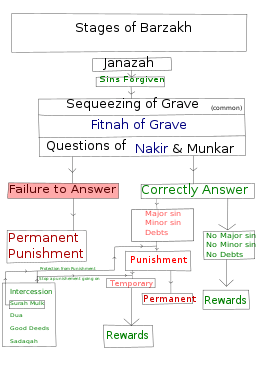Punishment of the Grave
Punishment of the Grave (Arabic: عذاب القبر ʿAdhāb al-Qabr, also translated torment of the grave) is an Judeo-Islamic concept whereby in the time between death and resurrection on the Day of Judgement. In Islam the souls of the unrighteous are punished by two angels in the grave, while the righteous find the grave "peaceful and blessed".[1]
| Part of a series on |
| Eschatology |
|---|
|
|
|
— Figures —
— Events — |
The punishment of the grave is not mentioned in the Quran, but in hadiths such as those compiled by Ibn Hanbal[1][2] and appears as early as the 9th century, still present among the majority of Sunnis and Shias.[3]
A similar concept can be found in Jewish mythology, there the wicked are punished by angels of destruction, in an intermediary state between the Resurrection of the dead and the individual death.
Islam

The Quran itself gives only brief references about the period between death and the resurrection. However it mentions that certain individuals such as martyrs are alive and not dead in 2:154 and also indicates, that some are already in hell in 71:25.[4] The term Barzakh indicates that the deceased and the living are entirely separated and can not interact with each other.[4] Otherwise the Barzakh refers to the whole period between the Day of Resurrection and death and is used synonymously for "grave".[5] Despite the brief mentionings of the Quran, Islamic tradition discusses elaborately, almost in graphic detail, as to what exactly happens before, during, and after death.
After the burial each person is interrogated in the grave by two angels, called Munkar and Nakir, appointed by God to question the dead in order to test their faith. The righteous believers answer correctly and live in peace and comfort while the sinners and disbelievers fail and punishments ensue.[6][7] In the life of Barzakh, the souls of the sinners and disbelievers are kept and punished in a place called Sijjin which is said to be located at the lowest level of the earth (traditionally hell, before the Day of resurrection or underworld).[8] The books containing the full records of their deeds are also kept here. On the other hand, the souls of the righteous believers are kept in a place called Illiyin. Their books of deeds are also kept here. According to some account, Illiyin is located in the heaven.[8] There is belief that the fire which represents the own bad deeds can already be seen during the Punishment of the Grave, and that the spiritual pain caused by this can lead to purification of the soul.[9]
Judaism
Rabbinic literature offer many traditions about punishing angels, chastising the dead.[10] In Jewish mythology, the souls of the wicked are punished in the hereafter by Dumah and three subordinative angels of destruction. Only on Sabbath they are released from their sufferings.[11]
See also
- Barzakh
- Islamic view of death
- Sheol (Judaism)
References
Notes
Citations
- J.A.C. Brown, Misquoting Muhammad, 2014: p.46
- "PUNISHMENT OF THE GRAVE (AZAB-E-QABR)".
- Sarah Tarlow, Liv Nilsson Stutz The Oxford Handbook of the Archaeology of Death and Burial OUP Oxford ISBN 9780191650390
- Jane I. Smith, Yvonne Yazbeck Haddad Islamic Understanding of Death and Resurrection State University of New York Press 1981 ISBN 9780873955072 p. 32
- Ashiq Ilahi Bulandshahri (1994). What Happens After Death. p. 2.
- Matt Stefon, ed. (2010). Islamic Beliefs and Practices. New York: Britannica Educational Publishing. pp. 83–85. ISBN 978-1-61530-060-0.
- Nigosian, S. A. (2004). Islam: Its History, Teaching, and Practices. Indiana University Press. pp. 123–4. ISBN 0-253-21627-3.
- Maariful Quran (exegesis of the Quran) by Muhammad Shafi Usmani. Karachi. Chapter 83.
- http://www.eslam.de/begriffe/f/feuer.htm
- Eichler, Paul Arno, 1889 Die Dschinn, Teufel und Engel in Koran [microform] p. 105-106 (German)
- Howard Schwartz Tree of Souls: The Mythology of Judaism Oxford University Press, 27.12.2006 ISBN 9780195327137 p. 236
Books, etc.
- Brown, Jonathan A.C. (2014). Misquoting Muhammad: The Challenge and Choices of Interpreting the Prophet's Legacy. Oneworld Publications. ISBN 978-1780744209. Retrieved 4 June 2018.